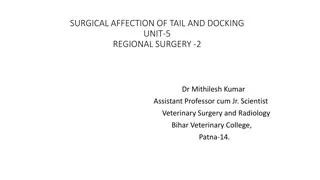
Amputation: Causes, Types, and Recovery Process
Explore the world of amputation, from its definition to causes and types, and learn about the recovery process involved. Understand how amputation can impact individuals and the different procedures involved in this surgical measure.
Download Presentation

Please find below an Image/Link to download the presentation.
The content on the website is provided AS IS for your information and personal use only. It may not be sold, licensed, or shared on other websites without obtaining consent from the author. If you encounter any issues during the download, it is possible that the publisher has removed the file from their server.
You are allowed to download the files provided on this website for personal or commercial use, subject to the condition that they are used lawfully. All files are the property of their respective owners.
The content on the website is provided AS IS for your information and personal use only. It may not be sold, licensed, or shared on other websites without obtaining consent from the author.
E N D
Presentation Transcript
StudyMafia.Org Amputation Submitted To: Studymafia.org Studymafia.org Submitted By:
TABLEOFCONTENT Introduction Definition Causes of Amputations Types of Amputation Amputation level The Amputation Procedure Recovery From Amputation Reference
INTRODUCTION Amputation is the removal of an extremity by trauma, prolonged constriction, medical illness or surgery. As a surgical measure, it is used to control pain or a disease process in the affected limb, such as malignancy or gangrene. In some cases, it is carried out on individuals as a preventative surgery for such problems. A special case is that of congenital amputation, a congenital disorder, where fetal limbs have been cut off by constrictive bands.
DEFINITION Amputation is the loss or removal of a body part such as a finger, toe, hand, foot, arm or leg. It can be a life changing experience affecting your ability to move, work, interact with others and maintain your independence. Continuing pain, phantom limb phenomena and emotional trauma can complicate recovery.
CAUSESOF AMPUTATIONS Congenital Congenical limb deficiency Phocomelia: "a congenital deformity in which the limbs are extremely shortened so that the feet and hands arise close to the trunk" 1.
CAUSESOF AMPUTATIONS Acquired Vascular Ischaemia Diabetes Frostbite Arterial insufficiency leading to death or decay of body tissue (gangrene) Chronic leg ulcer leading to septicemia. Infection e.g. Bone infection (Osteomyelitis) Malignant tumours e.g. sarcoma (cancer of the connective tissue) Trauma (limb buried under / crushed by heavy object, limb damaged by car accident, stabbing, gunshot, animal bite etc.); in some cases leading to 2.
TYPESOFAMPUTATION Traumatic amputation 1. Some examples of the ways in which a traumatic amputation can happen include the following: Accidents involving machinery, often in the workplace Road traffic accidents Explosions or other blast injuries Electric shocks Becoming trapped in building or car doors
TYPESOFAMPUTATION Surgical amputation 2. Surgical amputations have been a vital practice in medicine for thousands of years. A surgical amputation can be necessary after a person has suffered from a traumatic injury, and they can be carried out as part of the immediate emergency treatment to save the person s life or because their bones, tissuestissues or both have been so badly damaged that they cannot later be reconstructed. However, surgical amputation is usually considered to be a last resort, and if it is believed that a limb can be saved, surgeons will first try to do so.
AMPUTATION LEVEL
AMPUTATION LEVEL Lower Limb Hemipelvectomy Hip Disarticulation (HP) Transfemoral TF (Above Knee AKA) Knee Disarticulation (KD) Transtibial TT (Below Knee BKA) Ankle Disarticulation Symes Partial Foot PF Upper Limb Forequarter Shoulder Disarticulation (SD) Transhumeral (Above Elbow AE) Elbow Disarticulation (ED) Transradial (Below Elbow BE) Hand/ Wrist Disarticulation
UPPER LIMB Forequarter With a forequarter amputation, the upper arm bone (humerus) scapula, and clavicle, are all removed.
UPPER LIMB Shoulder Disarticulation With a shoulder disarticulation, the amputation is performed where the upper arm bone (humerus) meets the rest of the shoulder (clavicle and scapula).
UPPER LIMB Transhumeral In a transhumeral amputation (also known as above the elbow ), the amputation occurs through the upper arm bone (the humerus) , so that the elbow is no longer present.
UPPER LIMB Elbow Disarticulation In elbow disarticulation surgery the elbow joint is separated and the lower arm is removed. The entire upper arm (the humerus) is maintained.
UPPER LIMB Transradial For transradial (also known as below elbow ) amputations, the amputation occurs through the radius and ulna of the lower arm.
UPPER LIMB Hand/ Wrist Disarticulation For transcarpal (also known as Below elbow ) amputations, the amputation occurs through the radius and the metacarpal bones.
LOWER LIMB Foot amputation More than twelve different amputation levels are known in the area of the foot. They range from a toe amputation to a midfoot amputation to an amputation in the area of the tarsus. Silicone prostheses can be used for the prosthetic fitting.
LOWER LIMB Transtibial (Below Knee) amputation In the Below Knee amputation, which is an amputation in the area of the lower leg, the tibia and fibula are cut. A prosthetic foot, adapters and connecting elements to the prosthetic socket form the artificial limb for this level. The socket is the component that connects the prosthesis to the residual limb. What is known as a cosmetic cover can be applied over the skeleton of the artificial limb to make it visually appealing.
LOWER LIMB Knee Disarticulation (Through Knee) amputation Knee disarticulation is when the knee joint is cut, severing the lower leg. The thigh is retained entirely. A prosthetic foot, knee joint, adapters and connecting elements to the prosthetic socket form the artificial limb for this level. The socket is the component that connects the artificial limb to the residual limb.
LOWER LIMB Transfemoral (Above Knee) amputation In a transfemoral (Above Knee) amputation, which is an amputation in the area of the thigh, the thigh bone (femur) is cut. A prosthetic foot, knee joint, adapters and connecting elements to the prosthetic socket form the artificial limb for this level. The socket is the component that connects the artificial limb to the residual limb.
LOWER LIMB Hip Disarticulation (Through Hip) amputation In hip disarticulation, the amputation is performed in the area of the hip joint. With this type of amputation, the pelvis subsequently has to control the prosthesis. A prosthetic foot, knee joint, hip joint, adapters and connecting elements to the prosthetic socket are needed for the fitting of the artificial limb. The socket is the component that connects the artificial limb to the residual limb.
LOWER LIMB Hemipelvectomy In case of hemipelvectomy, the entire leg and parts of the pelvis up to the sacrum are amputated. With this type of amputation, the pelvis subsequently has to control the artificial limb. A prosthetic foot, knee joint, hip joint, adapters and connecting elements to the prosthetic socket are needed for the fitting of the artificial limb. The socket is the component that connects the artificial limb to the residual limb
THE AMPUTATION PROCEDURE An amputation usually requires a hospital stay of five to 14 days or more, depending on the surgery and complications. The procedure itself may vary, depending on the limb or extremity being amputated and the patient's general health. A doctor may use several methods to determine where to cut and how much tissue to remove. These include: Checking for a pulse close to where the surgeon is planning to cut Comparing skin temperatures of the affected limb with those of a healthy limb Looking for areas of reddened skin Checking to see if the skin near the site where the surgeon is planning to cut is still sensitive to touch
THE AMPUTATION PROCEDURE During the procedure itself, the surgeon will: Remove the diseased tissue and any crushed bone Smooth uneven areas of bone Seal off blood vessels and nerves Cut and shape muscles so that the stump, or end of the limb, will be able to have an artificial limb (prosthesis) attached to it The surgeon may choose to close the wound right away by sewing the skin flaps (called a closed amputation). Or the surgeon may leave the site open for several days in case there's a need to remove additional tissue.
RECOVERY FROM AMPUTATION Recovery from amputation depends on the type of procedure and anesthesia used. In the hospital, the staff changes the dressings on the wound or teaches the patient to change them. The doctor monitors wound healing and any conditions that might interfere with healing, such as diabetes or hardening of the arteries. The doctor prescribes medications to ease pain and help prevent infection.
RECOVERY FROM AMPUTATION Ideally, the wound should fully heal in about four to eight weeks. But the physical and emotional adjustment to losing a limb can be a long process. Long-term recovery and rehabilitation will include: Exercises to improve muscle strength and control Activities to help restore the ability to carry out daily activities and promote independence Use of artificial limbs and assistive devices Emotional support, including counseling, to help with grief over the loss of the limb and adjustment to the new body image
REFERENCES Google.com Wikipedia.org Studymafia.org Slidespanda.com
THANKS TO STUDYMAFIA.ORG






















